Today's film special is about one of the biggest box office successes of the Weimar Republic, the witty and enjoyable musical comedy Ein blonder Traum/Happy Ever After (Paul Martin, 1932). It featured the German dream couple of the 1930s, Lilian Harvey and Willy Fritsch, and Viennese actor-director Willi Forst.

German postcard by Ross Verlag, no. 6983/1. Photo: Ufa. Lilian Harvey, Willi Forst and Willy Fritsch in the musical comedy Ein blonder Traum/Happy Ever After (Paul Martin, 1932).

German postcard by Ross Verlag, no. 6980/1, 1931-1932. Photo: Ufa. Lilian Harvey in Ein blonder Traum/Happy Ever After (Paul Martin, 1932).

German postcard by Ross Verlag, no. 6980/2. Photo: Ufa. Photo Atelier Jacobi, Berlin. Lilian Harvey in Ein blonder Traum (Paul Martin, 1932).
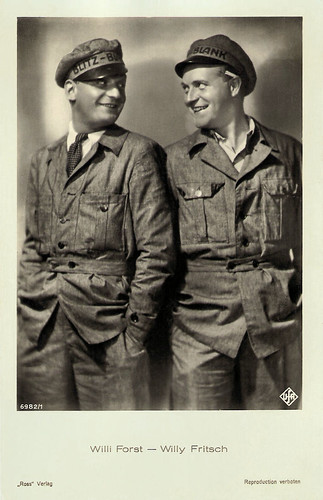
German postcard by Ross Verlag, no. 6982/1, 1931-1932. Photo: Ufa. Willi Forst and Willy Fritsch in Ein blonder Traum/Happy Ever After (Paul Martin, 1932).

German postcard by Ross Verlag, no. 6984/1, 1931-1932. Photo: Ufa. Lilian Harvey and Willi Forst in Ein blonder Traum/Happy Ever After (Paul Martin, 1932).
Ein blonder Traum/Happy Ever After is situated in Berlin, during the Depression of the early 1930s. Two window cleaners of the Blitz-Blank company, Willy I and Willy II (Willi Forst and Willy Fritsch), pedal with ladder and washing utensils crisscross through the city, from job to job, from house to house.
One day the blonde Jou-Jou (Lilian Harvey) enters their lives. They see her through the window of the American Consulate General. When Jou-Jou is about to be thrown out of the house by the rough porter, the two friends show their chivalrous side.
Jou-Jou, who earned her living as a projectile in a traveling circus, dreams of a film career in America. A certain Mr. Merryman, allegedly a major Hollywood mogul, has once promised her a career in the movies - against payment of a fee of $ 25.
The two Willy's want to help the girl. They decide to take care of her and help her achieve success.
The two lifelong friends take her home with them, so she and her shaggy mutt, called Buffalo, get a roof over their heads. Both window cleaners live poor but happily in cranky railway wagons in the middle of the meadow, far from the gates of the city.
Inevitably, both Willy I and Willy II fall in love with 'the blonde dream' and their friendship will be tested.
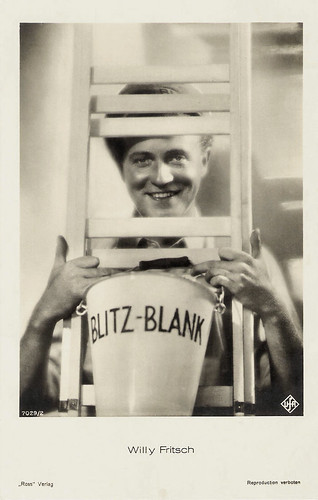
German postcard by Ross Verlag, no. 7029/2, 1932-1933. Photo: Ufa. Willy Fritsch in Ein blonder Traum/Happy Ever After (Paul Martin, 1932).
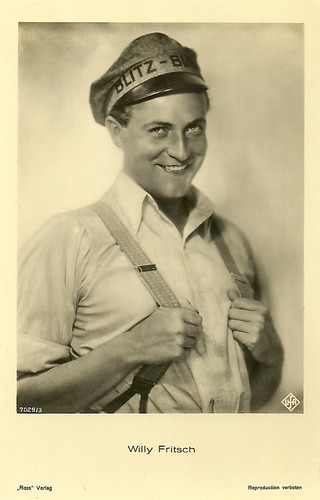
German postcard by Ross Verlag, no. 7029/3, 1932-1933. Photo: Ufa. Willy Fritsch in Ein blonder Traum/Happy Ever After (Paul Martin, 1932).
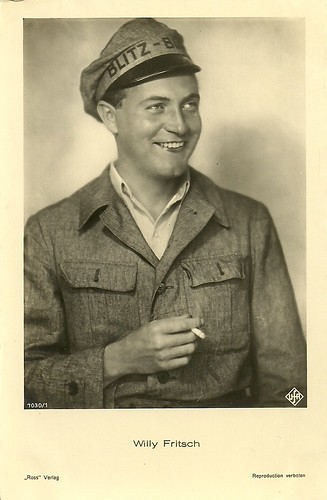
German postcard by Ross Verlag, no. 7030/1, 1932-1933. Photo: Ufa. Willy Fritsch in Ein blonder Traum/Happy Ever After (Paul Martin, 1932).
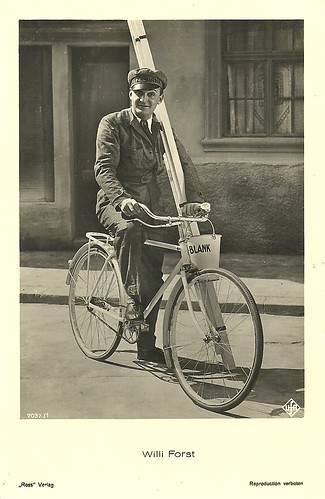
German postcard by Ross Verlag, no. 7032/1, 1932-1933. Photo: Ufa. Willi Forst in Ein blonder Traum/Happy Ever After (Paul Martin, 1932).
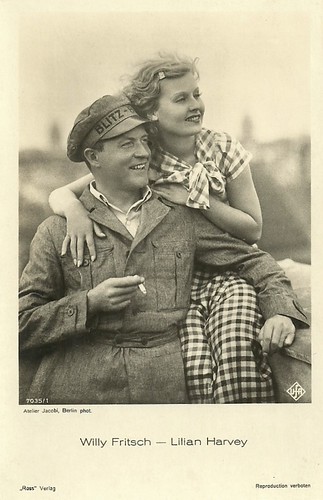
German postcard by Ross Verlag, no. 7035/1, 1932-1933. Photo: Ufa. Willy Fritsch and Lilian Harvey in Ein blonder Traum/Happy Ever After (Paul Martin, 1932).
Ein blonder Traum/Happy Ever After was directed by the Hungarian-born Paul Martin. It was his first sole directorial effort. Lilian Harvey, who was his partner, had promoted the quite inexperienced young director at the Ufa offices. The screenplay was written by Walter Reisch and the young Billy Wilder.
Werner Richard Heymann composed with music by Gérard Jacobson the songs Wir zahlen keine Miete mehr, wir sind im Grünen zuhaus (We no longer pay rent, we are at home in the countryside) and Irgendwo auf der Welt gibt's ein kleines bißchen Gluck (Somewhere in the world there's a little bit of luck). Both songs became evergreens. Heymann went on to have a career composing film scores in Hollywood after the Nazi takeover in Germany.
When the film went in premiere in Berlin, on 23 September 1932, the censors banned it for the youth, but a month later, on 27 October 1932, the ban was lifted again and the film was released for the youth. Ein blonder Traum/Happy Ever After became one of the biggest box office successes in the late phase of the Weimar Republic.
Simultaneously with the German version, there were two alternate language versions in French and English produced. In both versions Harvey repeated her part. The French version was called Un Rêve blond and had Henri Garat in the Fritsch role and Pierre Brasseur in the Forst role. The British version was entitled Happy Ever After, the two Willys were played by Jack Hulbert and Sonnie Hale.

German postcard by Ross Verlag, no. 7036/1, 1932-1933. Photo: Ufa. Willy Fritsch in Ein blonder Traum/Happy Ever After (Paul Martin, 1932).

German postcard by Ross Verlag, no. 7050/1, 1932-1933. Photo: Ufa. Willi Forst in Ein blonder Traum/Happy Ever After (Paul Martin, 1932).
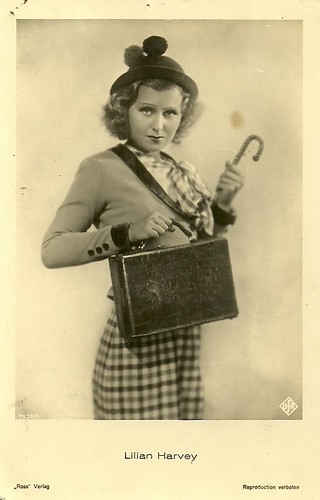
German postcard by Ross Verlag, no. 7135/1. Photo: Ufa. Photo Atelier Jacobi, Berlin. Lilian Harvey in Ein blonder Traum (Paul Martin, 1932).
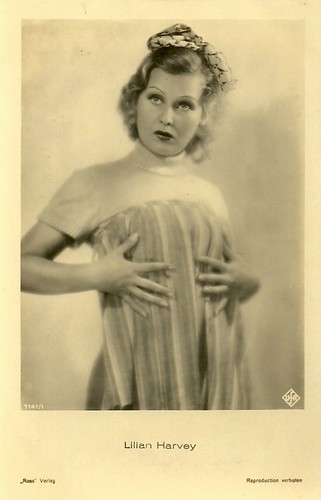
German postcard by Ross Verlag, no. 7141/1. Photo: Ufa. Photo Atelier Jacobi, Berlin. Lilian Harvey in Ein blonder Traum (Paul Martin, 1932).

German postcard by Ross Verlag, no. 7191/1. Photo: Ufa. Photo Atelier Jacobi, Berlin. Lilian Harvey in Ein blonder Traum (Paul Martin, 1932).
One of the highlights in the film is an amusing and innovative daydream sequence in which Jou-Jou (Lilian Harvey) dreams that she and her two gallants run in a train out of the city of Berlin under the Atlantic Ocean to NYC and across to Hollywood.
Upon their arrival in New York City, even the Statue of Liberty beckons them. In Hollywood, however, everybody only makes fun of her. Then Jou-Jou wakes up with the words 'Now I have dreamed'.
Six months later, in January 1933, Lilian Harvey actually arrived in Hollywood. Though she starred in a few films for Fox, Harvey was unable to make it in the USA and she returned to Germany.
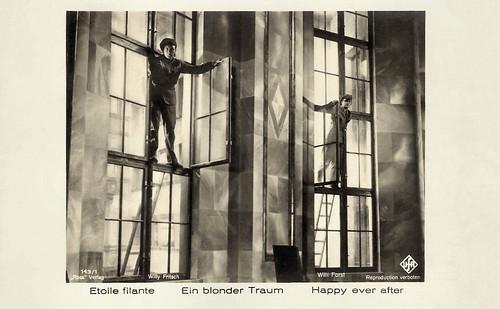
German postcard by Ross Verlag, no. 143/1. Photo: Ufa. Publicity still for Ein blonder Traum/Happy Ever After (Paul Martin, 1932).

German postcard by Ross Verlag, no. 143/3. Photo: Ufa. Publicity still for Ein blonder Traum/Happy Ever After (Paul Martin, 1932).

German postcard by Ross Verlag, no. 143/4. Photo: Ufa. Publicity still for Ein blonder Traum/Happy Ever After (Paul Martin, 1932).
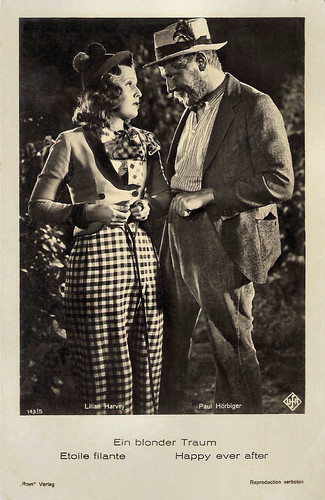
German postcard by Ross Verlag, no. 143/5. Photo: Ufa. Lilian Harvey and Paul Hörbiger in Ein blonder Traum/Happy Ever After (Paul Martin, 1932).
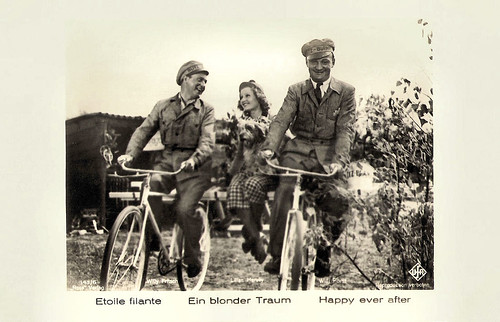
German postcard by Ross Verlag, no. 143/6 Photo: Ufa. Willi Forst, Lilian Harvey and Willy Fritsch in Ein blonder Traum/Happy Ever After (Paul Martin, 1932).
Sources: AllMovie, Wikipedia (German) and IMDb.

German postcard by Ross Verlag, no. 6983/1. Photo: Ufa. Lilian Harvey, Willi Forst and Willy Fritsch in the musical comedy Ein blonder Traum/Happy Ever After (Paul Martin, 1932).

German postcard by Ross Verlag, no. 6980/1, 1931-1932. Photo: Ufa. Lilian Harvey in Ein blonder Traum/Happy Ever After (Paul Martin, 1932).

German postcard by Ross Verlag, no. 6980/2. Photo: Ufa. Photo Atelier Jacobi, Berlin. Lilian Harvey in Ein blonder Traum (Paul Martin, 1932).

German postcard by Ross Verlag, no. 6982/1, 1931-1932. Photo: Ufa. Willi Forst and Willy Fritsch in Ein blonder Traum/Happy Ever After (Paul Martin, 1932).

German postcard by Ross Verlag, no. 6984/1, 1931-1932. Photo: Ufa. Lilian Harvey and Willi Forst in Ein blonder Traum/Happy Ever After (Paul Martin, 1932).
Blitz-Blank
Ein blonder Traum/Happy Ever After is situated in Berlin, during the Depression of the early 1930s. Two window cleaners of the Blitz-Blank company, Willy I and Willy II (Willi Forst and Willy Fritsch), pedal with ladder and washing utensils crisscross through the city, from job to job, from house to house.
One day the blonde Jou-Jou (Lilian Harvey) enters their lives. They see her through the window of the American Consulate General. When Jou-Jou is about to be thrown out of the house by the rough porter, the two friends show their chivalrous side.
Jou-Jou, who earned her living as a projectile in a traveling circus, dreams of a film career in America. A certain Mr. Merryman, allegedly a major Hollywood mogul, has once promised her a career in the movies - against payment of a fee of $ 25.
The two Willy's want to help the girl. They decide to take care of her and help her achieve success.
The two lifelong friends take her home with them, so she and her shaggy mutt, called Buffalo, get a roof over their heads. Both window cleaners live poor but happily in cranky railway wagons in the middle of the meadow, far from the gates of the city.
Inevitably, both Willy I and Willy II fall in love with 'the blonde dream' and their friendship will be tested.

German postcard by Ross Verlag, no. 7029/2, 1932-1933. Photo: Ufa. Willy Fritsch in Ein blonder Traum/Happy Ever After (Paul Martin, 1932).

German postcard by Ross Verlag, no. 7029/3, 1932-1933. Photo: Ufa. Willy Fritsch in Ein blonder Traum/Happy Ever After (Paul Martin, 1932).

German postcard by Ross Verlag, no. 7030/1, 1932-1933. Photo: Ufa. Willy Fritsch in Ein blonder Traum/Happy Ever After (Paul Martin, 1932).

German postcard by Ross Verlag, no. 7032/1, 1932-1933. Photo: Ufa. Willi Forst in Ein blonder Traum/Happy Ever After (Paul Martin, 1932).

German postcard by Ross Verlag, no. 7035/1, 1932-1933. Photo: Ufa. Willy Fritsch and Lilian Harvey in Ein blonder Traum/Happy Ever After (Paul Martin, 1932).
Evergreens
Ein blonder Traum/Happy Ever After was directed by the Hungarian-born Paul Martin. It was his first sole directorial effort. Lilian Harvey, who was his partner, had promoted the quite inexperienced young director at the Ufa offices. The screenplay was written by Walter Reisch and the young Billy Wilder.
Werner Richard Heymann composed with music by Gérard Jacobson the songs Wir zahlen keine Miete mehr, wir sind im Grünen zuhaus (We no longer pay rent, we are at home in the countryside) and Irgendwo auf der Welt gibt's ein kleines bißchen Gluck (Somewhere in the world there's a little bit of luck). Both songs became evergreens. Heymann went on to have a career composing film scores in Hollywood after the Nazi takeover in Germany.
When the film went in premiere in Berlin, on 23 September 1932, the censors banned it for the youth, but a month later, on 27 October 1932, the ban was lifted again and the film was released for the youth. Ein blonder Traum/Happy Ever After became one of the biggest box office successes in the late phase of the Weimar Republic.
Simultaneously with the German version, there were two alternate language versions in French and English produced. In both versions Harvey repeated her part. The French version was called Un Rêve blond and had Henri Garat in the Fritsch role and Pierre Brasseur in the Forst role. The British version was entitled Happy Ever After, the two Willys were played by Jack Hulbert and Sonnie Hale.

German postcard by Ross Verlag, no. 7036/1, 1932-1933. Photo: Ufa. Willy Fritsch in Ein blonder Traum/Happy Ever After (Paul Martin, 1932).

German postcard by Ross Verlag, no. 7050/1, 1932-1933. Photo: Ufa. Willi Forst in Ein blonder Traum/Happy Ever After (Paul Martin, 1932).

German postcard by Ross Verlag, no. 7135/1. Photo: Ufa. Photo Atelier Jacobi, Berlin. Lilian Harvey in Ein blonder Traum (Paul Martin, 1932).

German postcard by Ross Verlag, no. 7141/1. Photo: Ufa. Photo Atelier Jacobi, Berlin. Lilian Harvey in Ein blonder Traum (Paul Martin, 1932).

German postcard by Ross Verlag, no. 7191/1. Photo: Ufa. Photo Atelier Jacobi, Berlin. Lilian Harvey in Ein blonder Traum (Paul Martin, 1932).
An amusing and innovative daydream
One of the highlights in the film is an amusing and innovative daydream sequence in which Jou-Jou (Lilian Harvey) dreams that she and her two gallants run in a train out of the city of Berlin under the Atlantic Ocean to NYC and across to Hollywood.
Upon their arrival in New York City, even the Statue of Liberty beckons them. In Hollywood, however, everybody only makes fun of her. Then Jou-Jou wakes up with the words 'Now I have dreamed'.
Six months later, in January 1933, Lilian Harvey actually arrived in Hollywood. Though she starred in a few films for Fox, Harvey was unable to make it in the USA and she returned to Germany.

German postcard by Ross Verlag, no. 143/1. Photo: Ufa. Publicity still for Ein blonder Traum/Happy Ever After (Paul Martin, 1932).

German postcard by Ross Verlag, no. 143/3. Photo: Ufa. Publicity still for Ein blonder Traum/Happy Ever After (Paul Martin, 1932).

German postcard by Ross Verlag, no. 143/4. Photo: Ufa. Publicity still for Ein blonder Traum/Happy Ever After (Paul Martin, 1932).

German postcard by Ross Verlag, no. 143/5. Photo: Ufa. Lilian Harvey and Paul Hörbiger in Ein blonder Traum/Happy Ever After (Paul Martin, 1932).

German postcard by Ross Verlag, no. 143/6 Photo: Ufa. Willi Forst, Lilian Harvey and Willy Fritsch in Ein blonder Traum/Happy Ever After (Paul Martin, 1932).
Sources: AllMovie, Wikipedia (German) and IMDb.
No comments:
Post a Comment